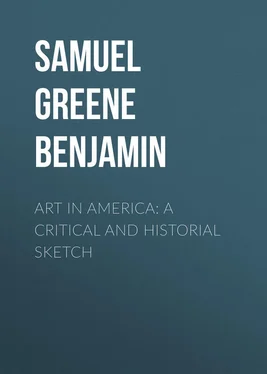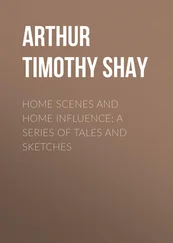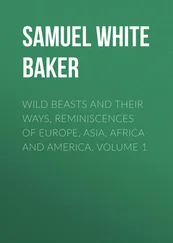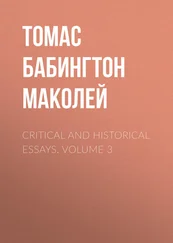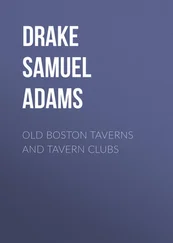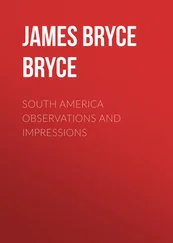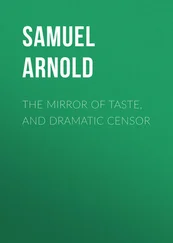Samuel Benjamin - Art in America - A Critical and Historial Sketch
Здесь есть возможность читать онлайн «Samuel Benjamin - Art in America - A Critical and Historial Sketch» — ознакомительный отрывок электронной книги совершенно бесплатно, а после прочтения отрывка купить полную версию. В некоторых случаях можно слушать аудио, скачать через торрент в формате fb2 и присутствует краткое содержание. Жанр: foreign_antique, foreign_prose, на английском языке. Описание произведения, (предисловие) а так же отзывы посетителей доступны на портале библиотеки ЛибКат.
- Название:Art in America: A Critical and Historial Sketch
- Автор:
- Жанр:
- Год:неизвестен
- ISBN:нет данных
- Рейтинг книги:4 / 5. Голосов: 1
-
Избранное:Добавить в избранное
- Отзывы:
-
Ваша оценка:
- 80
- 1
- 2
- 3
- 4
- 5
Art in America: A Critical and Historial Sketch: краткое содержание, описание и аннотация
Предлагаем к чтению аннотацию, описание, краткое содержание или предисловие (зависит от того, что написал сам автор книги «Art in America: A Critical and Historial Sketch»). Если вы не нашли необходимую информацию о книге — напишите в комментариях, мы постараемся отыскать её.
Art in America: A Critical and Historial Sketch — читать онлайн ознакомительный отрывок
Ниже представлен текст книги, разбитый по страницам. Система сохранения места последней прочитанной страницы, позволяет с удобством читать онлайн бесплатно книгу «Art in America: A Critical and Historial Sketch», без необходимости каждый раз заново искать на чём Вы остановились. Поставьте закладку, и сможете в любой момент перейти на страницу, на которой закончили чтение.
Интервал:
Закладка:
The art-feeling, which made itself apparent, vaguely and abortively, during our colonial period, began to demand freer and fuller expression soon after the new Republic had declared its independence; and, with scarce any patronage from the Government, assumed a degree of excellence surprising under the circumstances, and rarely reached by a nation in so short a time.
We recall no art of the past the order and conditions of whose growth resemble those of ours, except that of Holland after its wars of independence with Spain. The bane and the blessing of our art have been in the enormous variety of influences which have controlled its action. This has been a bane, because it has, until recently, prevented the concentration of effort which might lead to grand results and schools. It has been a blessing, because individual expression has thus found a vent, and mannerism has not yet become a conventional net, so thrown around our art as to prevent free action and growth. The American art of the last two generations has resembled the restless activity of a versatile youth, who seeks in various directions for the just medium by which to give direction to his life-work. If there has been, on the whole, a national bias in one direction more than another, it has been for landscape-painting.
Our intellectual state has also resembled the many-sided condition of Germany in the Middle Ages, waking up from the chaos of the Dark Ages, but broken up into different States, and representing different religions and races. But our position has been even more agitated and diverse; a general restlessness has characterized the community – a vast intellectual discontent with the present. Although strongly moved by pride of country, we have also been keenly sensitive to foreign influences, and have received impressions from them with the readiness of a photographic plate, although until recently the result has been assimilation rather than imitation; while internally we have been trying to harmonize race and sectional differences, which as yet are far from reaching homogeneity.
Together with all these individual influences must be included one of general application, to which nearly all our artists, of whatever race or section, have been subject in turn. In other countries the people have, by a long preparation, become ready to meet the artist half-way in appreciating and aiding him in his mission, either from the promptings of the religious sentiment to which his art has given ocular demonstration, or from a dominating and universal sense of beauty. With us it has been quite otherwise; for the artists have been in advance of public sentiment, and have had the misfortune to be forced to wait until the people could come up to them. In addition to the fact that in New England Puritan influences were at first opposed to art, the restless, surging, unequal, widely differing character of our people, brought face to face with the elementary problems of existence, founding new forms of government, and welding incongruous factors into one race and nation – in a word, wresting from fate our right to be – made us indifferent to the ideal, except in sporadic and individual cases, which indicated here and there that below the surface the poetic sentiment was preparing to assert itself; and that we, in turn, were preparing to acknowledge the great truth that art is an instinctive yearning of the race to place itself in accord with the harmony which rules the universe.
The result has been that a very large proportion of the artists of this period of our history have been compelled to endure far more than the traditionary hardships of the profession. They have been obliged to devote some of the best years of their lives to trade, and have not been able to take up art until late. To accuse American artists, as a class, of being mercenary – a charge made quite too often – is really something akin to irony, so much more successful pecuniarily would the majority of them have been in mercantile pursuits. The heroism of our early painters, struggling, in obscure corners of the country, for opportunities to express their yearning after the ideal, without instruction, without art-influences, meeting little or no sympathy or encouragement, and in spite of these obstacles often achieving a respectable degree of excellence, is one of the most interesting, instructive, and sublime episodes in the history of art.
Growing out of this hesitating condition of our early art may be discerned a secondary cause, which occurred in so many cases as to be justly considered one of the forces which formed the careful, minute, painstaking style of much of our landscape art. We refer to the fact that many of the best of our early painters were first engravers on wood and steel. This gave them a minute, formal, and precise method of treatment, which led them to look at details rather than breadth of effect.
When we turn to the influences from abroad which stimulated American art during this period, we find that, while they fostered the growth of a certain æsthetic feeling, they at the same time instilled conventional methods and principles that deferred the development of a higher kind of art. It is greatly to be regretted that, notwithstanding the friendly relations between the United States and France, our art, when it was first looking to Europe for direction, should not have come in contact with that of France, which at that time, led by Gericault, Rousseau, Troyon, Delacroix, and other rising men, was becoming the greatest pictorial school since the Renaissance. But Italian art at that time was sunk to the lowest depths of conventionalism; while the good in the English art of the time was represented less by a school than by a few individuals of genius – Turner, Wilkie, Constable – who were so original that they failed to attract students whose first art ideas had been obtained in Italy.
The influence of Italy on our early art was shown by the tendency of our painters in that direction – as now they go to France and Germany – and this was due primarily to Allston and Vanderlyn. The latter, when at Rome, occupied the house of Salvator Rosa – apparently a trivial incident, but if we could trace all the influence it may have had on the fancy and tastes of the young American artist, we might find it was a powerful contributor to the formation of the early style of the landscape artists who followed him to Italy. This bias was also greatly assisted by the many paintings imported at that time from the Italian peninsula, which were either originals, bought cheaply during the disturbances which then convulsed Europe, or copies of more or less merit. These works made their way gradually over our country, from Boston to New Orleans; and, with the rapidly shifting fortunes of our families, have often been so completely placed out of sight and forgotten, that it is not an unfrequent instance for one to be unearthed in a remote country village, or farm-house that would never be suspected of harboring high art.
The larger portion of these foreign works came first to Boston, and were hidden away somewhere in that vicinity, as in the case of the collection bequeathed to Bowdoin College by its founder; whose best specimens were eventually sold and scattered for a mere song by a faculty who were ignorant of their value, and thought they might at the same time aid morality and add an honest penny to the funds of the institution by selling its precious nudities, and thus remove them from the student's eye. As Allston and Stuart, who were colorists, also settled in Boston, after years of foreign study, these two circumstances contributed to make the Boston school from the first one of color – a fact less pronounced in the early art of New York.
It is to West and Allston and Trumbull that we are to attribute the English element in our arts. The prominent position they then occupied before the American public made their example and opinions of great importance with their countrymen, and undoubtedly contributed to suggest one of the most characteristic traits of American art, that is, the tendency to make art a means for telling a story, which has always been a prominent feature of English art. May we not also trace to English literature the bias which unconsciously led our painters to turn their attention to landscape with a unanimity that has until recently made our pictorial art distinctively a school of landscape painting? Cowper, Byron, and Wordsworth introduced landscape into poetry, and undoubtedly impelled English art in the same direction; and it was exactly at that time that our own poet, Bryant, undoubtedly influenced at the turning-point of his character by Wordsworth's solemn worship of nature, was becoming the pioneer of American descriptive poetry; while Irving was introducing the picturesque into our literature; and Cooper, with his vivid descriptions of our forests, was, like Irving, creating a whole class of subjects that were to be illustrated by the American artists of this period.
Читать дальшеИнтервал:
Закладка:
Похожие книги на «Art in America: A Critical and Historial Sketch»
Представляем Вашему вниманию похожие книги на «Art in America: A Critical and Historial Sketch» списком для выбора. Мы отобрали схожую по названию и смыслу литературу в надежде предоставить читателям больше вариантов отыскать новые, интересные, ещё непрочитанные произведения.
Обсуждение, отзывы о книге «Art in America: A Critical and Historial Sketch» и просто собственные мнения читателей. Оставьте ваши комментарии, напишите, что Вы думаете о произведении, его смысле или главных героях. Укажите что конкретно понравилось, а что нет, и почему Вы так считаете.
